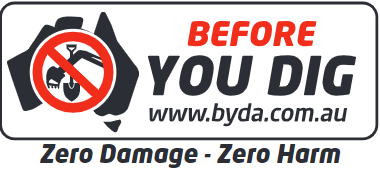It is for your own safety and in your company’s interests to obtain a confirmation of pipeline locations when planning to excavate on or near the SEA Gas easement. The following points act as a guideline only and there must be consultation with SEA Gas before undertaking any earthworks on or near the pipeline easement that may impact on our asset, your safety, or the safety of others.
Depth of pipeline – can be less than a metre in some areas. Please contact SEA Gas for further information.
Width of easement – is usually about 25 metres, however it does vary in width in certain areas.
Land development in the vicinity of the pipeline – changes in land use are subject to detailed review in accordance with legislated standards. SEA Gas must be consulted on development activities in the vicinity of the pipeline.
Restrictions for excavations across, adjacent to and crossings of the pipeline easement for other services – ANY excavations across or adjacent to the pipeline easement must be undertaken with a SEA Gas representative on-site prior to any work commencing.
The minimum separation distances for pipe services crossings – a minimum of 500mm however greater separation distance should be maintained wherever possible.
Set back distances applicable to construction procedures – SEA Gas needs access to the pipeline in case of emergencies where we may need to dig up a section. In general, a minimum distance of 20 metres is required from the centreline of the pipeline for access earthmoving equipment and the stockpiling of backfill.
Fencing – can run across the pipeline easement once a depth of cover has been completed by SEA Gas to determine where the strainers / posts can go.
Easement access – Access is required over the pipeline easement area for maintenance patrols.
Pressure – The high pressure pipeline operates at a maximum pressure of 15300kpa or over 2220psi. (Your car tyre pressure is usually around 40psi.)
Pipeline location and protection – The SEA Gas pipeline location service is free of charge to you or your company or contractor. SEA Gas will be pleased to assist with your development proposal to ensure that risks to public safety and to the asset are as low as reasonably practical. Once SEA Gas has received your plans of where the proposed infrastructure is to be located, we will conduct a risk assessment and determine whether further protection measures will need to be taken, i.e. concrete slabs, build up of cover, etc.
Click here to download the “Guideline for the Planning and Development of Land in the Vicinity of High Pressure Natural Gas and Liquid Petroleum Pipelines“.




